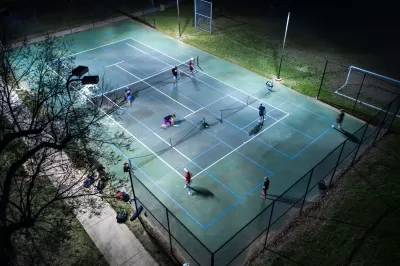Pickleball may be America's fastest growing sport, but it is not universally loved because of the noise it causes. Learn one expert's ideas for mitigating the noise impacts.

Pickleball, a racquet-based sport that combines elements of tennis, badminton and ping-pong, is one of the fastest-growing sports in the United States. It can be played indoors or outdoors, and the courts and nets are smaller than their tennis counterparts. Using a paddle and a plastic ball with holes, the sport can be played either as a singles or a doubles game. Pickleball first found popularity among active adults and retirees as a less physically demanding alternative to tennis, but today the sport is enjoyed by all ages and skill levels.
While playing pickleball offers health and other benefits, it also has impacts that need to be considered and mitigated. The major negative impact associated with pickleball is noise. When the hard surface of the pickleball racket connects with the hard surface of the ball, sound waves vibrate rapidly, registering a decibel level of around 70 dBA at 100 feet from the court. (In comparison, tennis noise is closer to 40 dBA.)
This article by Mark Dent features Bob Unetich, a retired engineer, university professor, and founder of Pickleball Sound Mitigation LLC. He has become a go-to source for information in the pickleball wars, studying everything from paddles to the placement of courts. When Unetich has discussions with clients, he gives a primary piece of advice: Do whatever you can to ensure that the average sound emanating from the court to the nearest homes is 50 dBA or less.
According to Unetich's studies and experience, residents of suburban areas generally do not complain about that noise level, which is a few decibels above typical suburban background noise. In noisier city environments, Unetich has proposed a maximum noise limit of 3 dBA above the background sound. Getting down to 50 dBA is possible with planning. Data from one of Unetich’s papers estimates that even in a wide-open space the sound of pickleball will likely be tolerable to people living at a distance of 977 feet or farther from a court, and anecdotally he has rarely heard complaints from people living more than roughly 500 feet away.
For more information, please read the source article.
FULL STORY: One man’s quest to make pickleball quiet

Alabama: Trump Terminates Settlements for Black Communities Harmed By Raw Sewage
Trump deemed the landmark civil rights agreement “illegal DEI and environmental justice policy.”

Planetizen Federal Action Tracker
A weekly monitor of how Trump’s orders and actions are impacting planners and planning in America.

The 120 Year Old Tiny Home Villages That Sheltered San Francisco’s Earthquake Refugees
More than a century ago, San Francisco mobilized to house thousands of residents displaced by the 1906 earthquake. Could their strategy offer a model for the present?

In Both Crashes and Crime, Public Transportation is Far Safer than Driving
Contrary to popular assumptions, public transportation has far lower crash and crime rates than automobile travel. For safer communities, improve and encourage transit travel.

Report: Zoning Reforms Should Complement Nashville’s Ambitious Transit Plan
Without reform, restrictive zoning codes will limit the impact of the city’s planned transit expansion and could exclude some of the residents who depend on transit the most.

Judge Orders Release of Frozen IRA, IIJA Funding
The decision is a victory for environmental groups who charged that freezing funds for critical infrastructure and disaster response programs caused “real and irreparable harm” to communities.
Urban Design for Planners 1: Software Tools
This six-course series explores essential urban design concepts using open source software and equips planners with the tools they need to participate fully in the urban design process.
Planning for Universal Design
Learn the tools for implementing Universal Design in planning regulations.
Clanton & Associates, Inc.
Jessamine County Fiscal Court
Institute for Housing and Urban Development Studies (IHS)
City of Grandview
Harvard GSD Executive Education
Toledo-Lucas County Plan Commissions
Salt Lake City
NYU Wagner Graduate School of Public Service





























